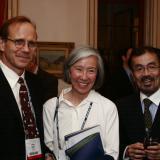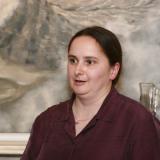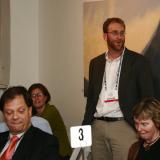2005 Gruber Neuroscience Prize
The work of Professor Masakazu Konishi and Professor Eric Knudsen on the neural basis of sound localization resulted in the discovery of a topographical map of auditory space in the brains of barn owls. The map, which was unexpected and had been argued against in the literature of the time, led directly to discoveries of fundamental brain mechanisms of information processing and learning.
2005 Neuroscience Prize Recipients
Laureate Profile
Owl brain maps reveal how we hear and learn.
The way owls pinpoint their prey in absolute darkness has taught us how we map sound in our brains. And it’s led to better understandings of how our brains learn and change with experience.
For their initial discovery of the topographical sound map in an owl’s brain, and two decades of follow-on research into sound perception and brain learning, the 2005 Neuroscience Prize of the Peter and Patricia Gruber Foundation was awarded to Masakazu Konishi and Eric Knudsen.
Owls have one of the most sensitive auditory systems in the natural world, allowing them to hunt their prey at night. The accuracy with which owls target the direction of their prey (using the time difference between a sound arriving at each ear) is around three times than that of a human. That’s why they made an ideal research animal for Masakazu Konishi and Eric Knudsen, who wanted to study the perception of sound location – how we know where something is when we hear it.
To their surprise, they found that the owl’s brain creates a map. In the owl’s midbrain there is a two-dimensional layout consisting of thousands of neurons. A noise from one location in the world activated only the neurons in a specific position in the map. If the noise moved up, down, left or right, the patch of activated neurons moved across the brain map in a corresponding pattern.
That led to more questions. Like: how do owls make the map?
How do their brains translate sound signals into spatial signals? How old are they when they learn to make a map from sounds? Do young owls learn new maps more easily than do adult owls?
Konishi and Knudsen have continued working on the answers to these and other questions in their separate labs since 1979. Among their many results:
- A single neuron can take two signals such as timing and intensity of sound and multiply them together • The timing and loudness information in a sound are analyzed in different, parallel pathways in the brain – even though they start together in the same nerves in the ear and recombine at the same brain cells, they don’t go down the same pipe.
- Learn something at a young age, and it’s much easier to re-learn it when you’re an adult. Owls that learned to cope with something new as juveniles, and wired a new pathway in their brain for it, didn’t lose the wiring even when things went back to normal. As soon as they needed the learned pathway again, it was there and ready.
- And an old owl can learn new tricks – as long as it can learn them gradually. Older owls can’t adapt to radical changes very easily. But give them the change in small pieces and they learn to cope much better. This means patients recovering from strokes and other brain damage may be able to recover far more capability than their doctors previously thought, if given the right training regimen in which recovery is broken down into small increments. Professor Masakazu (Mark) Konishi is the Bing Professor of Behavioral Biology at the California Institute of Technology. Professor Eric I. Knudsen is the Sewall Professor of Neurobiology at the School of Medicine, Stanford University.
Citation
The 2005 Neuroscience Prize of the Peter Gruber Foundation is hereby proudly presented to Dr. Masakazu Konishi, California Institute of Technology, and Dr. Eric Knudsen, Stanford University, whose studies provided the keys for our understanding of the basis of sound localization and neural plasticity in the auditory system. The work is a paradigm for the precise organization of a sensory system and its ability to adapt to environmental experiences. Their work established the topographic map of auditory space in the midbrain of the barn owl and elucidated the mechanisms of plasticity that calibrate the auditory map with the neighboring map of the visual world. The elegance and high standard of their work, and their mentorship and care of their disciples have made Konishi and Knudsen models for scientists all over the world.























